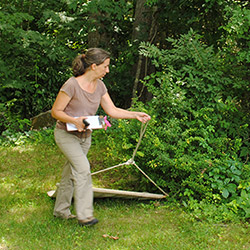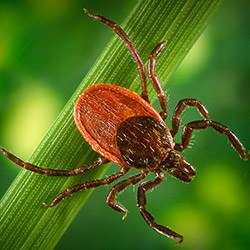
Ticks, Mice and Microbes—Studying Disease Spread

Credit: Oscar Gonzalez (Diuk-Wasser’s husband)
Maria Diuk-Wasser
Hometown: Buenos Aires, Argentina
Childhood dream job: Veterinarian
Hobbies: Hiking and gardening with her son (age 10) and daughter (age 7)
Favorite music: Salsa
Worksite: Lab at Columbia University and forests in coastal New England
Hometown: Buenos Aires, Argentina
Childhood dream job: Veterinarian
Hobbies: Hiking and gardening with her son (age 10) and daughter (age 7)
Favorite music: Salsa
Worksite: Lab at Columbia University and forests in coastal New England
Maria Diuk-Wasser grew up on the 10th floor of an apartment building in the middle of a bustling city. With no forests or meadows nearby, she read book after book about the natural world and surrounded herself with houseplants.
“I yearned for nature,” Diuk-Wasser says. “But my parents couldn’t provide it. They’re city people. They didn’t know anything about hiking or camping.”
These days, Diuk-Wasser still spends a lot of time in a city—she’s a professor at Columbia University in New York, the most populous city in the U.S.—but she also gets plenty of time in the woods. She hikes for hours through coastal New England forests, some of the loveliest in the country, searching for what many consider less-than-lovely inhabitants: mice and ticks.
Diuk-Wasser studies diseases carried by blacklegged ticks, more commonly known as deer ticks. These orange-brown critters, about the size of a sesame seed, can carry several disease-causing microorganisms. When it feeds, a tick not only sucks the blood of an animal, it also injects the animal (or person) with any pathogens it carries.
Making Connections
Diuk-Wasser didn’t start out with an interest in human diseases. In college, she studied ecology. She started to study bird behavior during her Ph.D. program at the University of California, Los Angeles. “But the birds wouldn’t cooperate,” she quips.
So she came up with another project—exploring the link between mosquito abundance and malaria transmission in rice-cropping villages in Mali. The new project was a perfect fit.
“I love being in the field, searching for the connections between the ecology of natural systems and human diseases,” she says.
She’s continuing to study such connections by examining how ticks and mice introduce diseases into human populations.
“I’m interested in the emergence of new diseases and diseases that are expanding geographically,” she says.

Diuk-Wasser combs the forests of New England for ticks carrying the pathogens that cause Lyme and babesiosis diseases. Credit: Michael Greenberg, Yale University.
In particular, she is focused on whether Lyme disease, which is now widespread in New England and the Upper Midwest, drives the emergence and spread of another tick-borne disease, babesiosis.
Babesiosis is much less common than Lyme disease. Some people with babesiosis have no symptoms. Others experience many, including fever, nausea and fatigue. For the elderly or people with weakened immune systems, the disease can be life-threatening.
Diuk-Wasser wants to predict where babesiosis will spread next so that people in high-risk areas can be educated about the disease and doctors can be on the lookout for symptoms.
Can One Disease Lead to Another?
Lyme disease and babesiosis are most commonly found in areas near forests, where deer ticks thrive. Babesiosis is expanding its geographic range, but only within areas where Lyme disease is already prevalent. So, Diuk-Wasser wonders, is there something about Lyme disease that enables—or even promotes—the emergence and spread of babesiosis?
If so, it certainly wouldn’t be the first example of a disease that moves into a new area by “hitchhiking” on a different disease, she says. A well-known example is HIV and tuberculosis. The prevalence of tuberculosis increased following the HIV epidemic, but only in the same geographies and populations that already had high levels of HIV infection.
Diuk-Wasser says a similar pattern is emerging between Borrelia burgdorferi (the Lyme disease bacterium), and Babesia microti (the microscopic parasite that causes babesiosis). First, Borrelia infects an area. A couple decades later, Babesia creeps in.
“We want to know why Babesia is following Borrelia and why there is a 20-year delay,” says Diuk-Wasser. “How far will Babesia spread—will it fill the entire Borrelia range, or stay as a subset? What factors play a role in how far and how fast Babesia spreads?”
To answer those and other questions, Diuk-Wasser’s research group is using laboratory experiments, field work and computational modeling.
Puzzling Pathogens
Diuk-Wasser started her laboratory experiments while working at the Yale School of Public Health. Her team there examined how tick larvae pick up Babesia by biting white-footed mice, one of the pathogen’s natural hosts.

Deer ticks can transmit several diseases, including Lyme disease and babesiosis. Credit: Centers for Disease Control and Prevention.
The researchers found that tick larvae were actually more likely to become infected with Babesia if they fed on mice that carried both pathogens (Babesia and Borrelia), than if they fed on mice that carried only Babesia.
To those of us who don’t study infectious diseases, these results might seem counterintuitive. To Diuk-Wasser and her team, they made sense. Pathogens do not exist independently, she explains. Rather, they interact with one another inside their hosts. Their fates—whether they reproduce, die or spread to a new host—are often intricately intertwined.
“To truly understand the spread of disease, we need to know how pathogens interact,” she says. “Studying multiple pathogens at once is going to be the rule rather than the exception.”
From Lab to Field
Even though the laboratory findings suggest that Borrelia aids the transmission of Babesia, that’s not the whole story. The laboratory experiments were tightly controlled and only account for some of the players—mice, ticks and two pathogens.
In the wild, environmental conditions vary, the diseases spread over a 2-year cycle, and transmission can involve many players. Throughout their life cycle, ticks feed not only on mice, but also on other small mammals and birds, then move on to larger mammals, especially white-tailed deer. In addition, Babesia and Borrelia are just two of many different microorganisms in the ecosystem that might influence disease spread.
To test whether the results from her lab experiment hold true in the wild, Diuk-Wasser set up study sites in forests across New England, where she and her graduate students and colleagues now regularly capture mice in live traps. The scientists take ear biopsies, blood samples and ticks from the mice, testing them all for Babesia, Borrelia and other pathogens. Before being released, mice receive tiny ear tags that identify them should they be captured again.
Mice that are captured more than once provide the research team with the most information because they help reveal how new diseases enter and spread through a population. Diuk-Wasser’s group is also looking at how Borrelia and Babesia interact inside mice and how these interactions cause multiple infections in ticks that feed on the mice. The early results already indicate some synergy.
“We’re more likely to find the two pathogens living together in a tick than you would expect by chance,” she says.
Diuk-Wasser and her team are in the fourth year of the study. Their traps have successfully captured mice more than 1,000 times. By the end of summer 2016, they expect to reach their goal of recapturing 200 individual mice three or more times. With this many recaptures, Diuk-Wasser believes they’ll have a broad enough sample to confirm, in a natural setting, what they observed in the laboratory—that once mice are infected with Borrelia, they are also more likely to get infected with Babesia.
The scientists will use their field data, along with results of the laboratory experiments, to create a mathematical model to predict where the pathogens will spread next.
“I love doing field work,” says Diuk-Wasser. “But I also love getting to sit at a computer and connect all of the pieces of this complicated system.”
As Lyme disease and babesiosis continue to spread and new diseases continue to emerge, Diuk-Wasser is bound to find plenty to do both inside and out.























.png)











No hay comentarios:
Publicar un comentario